A Mixed Finite Volume Element Method for Time-Fractional Damping Beam Vibration Problem
Abstract
:1. Introduction
2. Fully Discrete MFVE Scheme
3. Some Lemmas
4. Stability Analysis for Fully Discrete MFVE Scheme
5. Convergence Analysis for Fully Discrete MFVE Scheme
6. Numerical Examples
7. Conclusions and Suggestions
Author Contributions
Funding
Institutional Review Board Statement
Informed Consent Statement
Data Availability Statement
Conflicts of Interest
References
- Nigmatullin, R.R. The realization of the generalized transfer equation in a medium with fractal geometry. Phys. Status Solidi (b) 1986, 133, 425–430. [Google Scholar] [CrossRef]
- Nikan, O.; Avazzadeh, Z.; Tenreiro Machado, J. Numerical approach for modeling fractional heat conduction in porous medium with the generalized Cattaneo model. Appl. Math. Model. 2021, 100, 107–124. [Google Scholar] [CrossRef]
- SHAN, L.; TONG, D.; XUE, L. Unsteady Flow of Non-Newtonian Visco-Elastic Fluid in Dual-Porosity Media with The Fractional Derivative. J. Hydrodyn. Ser. B 2009, 21, 705–713. [Google Scholar] [CrossRef]
- Luchko, Y.; Punzi, A. Modeling anomalous heat transport in geothermal reservoirs via fractional diffusion equations. GEM—Int. J. Geomath. 2010, 1, 257–276. [Google Scholar] [CrossRef]
- Wang, W.; Xia, X.G.; Zhang, S.; He, C.; Chen, L. Vector total fractional-order variation and its applications for color image denoising and decomposition. Appl. Math. Model. 2019, 72, 155–175. [Google Scholar] [CrossRef]
- Carlson, G.E.; Halijak, C. Approximation of Fractional Capacitors by a Regular Newton Process. IEEE Trans. Circuit Theory 1964, 11, 210–213. [Google Scholar] [CrossRef]
- Tong, D.; Wang, R. Analysis of the flow of non-Newtonian visco-elastic fluids in fractal reservoir with the fractional derivative. Sci. China Phys. Mech. Astron. 2004, 47, 424–441. [Google Scholar] [CrossRef]
- Sugimoto, N. Burgers equation with a fractional derivative; hereditary effects on nonlinear acoustic waves. J. Fluid Mech. 1991, 225, 631–653. [Google Scholar] [CrossRef]
- Gemant, A. A Method of Analyzing Experimental Results Obtained from Elasto-viscous Bodies. Physics 1936, 7, 311–317. [Google Scholar] [CrossRef]
- Demir, D.; Bildik, N.; SINIR, B. Application of fractional calculus in the dynamics of beams. Bound. Value Probl. 2012, 2012. [Google Scholar] [CrossRef] [Green Version]
- Demir, D.; Bildik, N.; SINIR, B. Linear dynamical analysis of fractionally damped beams and rods. J. Eng. Math. 2014, 85, 131–147. [Google Scholar] [CrossRef]
- Parmoon, R.; Rashidinia, J.; Parsa, A.; Haddadpour, H.; Salehi, R. Application of radial basis functions and sinc method for solving the forced vibration of fractional viscoelastic beam. J. Mech. Sci. Technol. 2016, 30, 3001–3008. [Google Scholar] [CrossRef]
- Cajic, M.; Karlicic, D.; Lazarevic, M. Damped vibration of a nonlocal nanobeam resting on viscoelastic foundation: Fractional derivative model with two retardation times and fractional parameters. Meccanica 2016, 52, 363–382. [Google Scholar] [CrossRef]
- Liu, D.; Xu, W.; Xu, Y. Stochastic response of an axially moving viscoelastic beam with fractional order constitutive relation and random excitations. Acta Mech. Sin. 2013, 29, 443–451. [Google Scholar] [CrossRef]
- Rossikhin, Y.; Shitikova, M. Application of fractional derivatives to the analysis of damped vibrations of viscoelastic single mass system. Acta Mech. 1997, 120, 109–125. [Google Scholar] [CrossRef]
- Faraji Oskouie, M.; Ansari, R.; Sadeghi, F. Nonlinear vibration analysis of fractional viscoelastic Euler-Bernoulli nanobeams based on the surface stress theory. Acta Mech. Solida Sin. 2017, 30, 416–424. [Google Scholar] [CrossRef]
- Yang, T.; Fang, B. Stability in parametric resonance of an axially moving beam constituted by fractional order material. Arch. Appl. Mech. 2012, 82, 1763–1770. [Google Scholar] [CrossRef]
- Cao, D.; Gao, Y.; Wang, J.; Yao, M.; Zhang, W. Analytical analysis of free vibration of non-uniform and non-homogenous beams: Asymptotic perturbation approach. Appl. Math. Model. 2019, 65, 526–534. [Google Scholar] [CrossRef]
- Liang, Z.; Tang, X. Analytical solution of fractionally damped beam by Adomian decomposition method. Appl. Math. Mech. (Engl. Ed.) 2007, 28, 219–228. [Google Scholar] [CrossRef]
- Patnaik, S.; Sidhardh, S.; Semperlotti, F. A Ritz-based finite element method for a fractional-order boundary value problem of nonlocal elasticity. Int. J. Solids Struct. 2020, 202, 398–417. [Google Scholar] [CrossRef]
- Stempin, P.; Sumelka, W. Formulation and experimental validation of space-fractional Timoshenko beam model with functionally graded materials effects. Comput. Mech. 2021, 68, 697–708. [Google Scholar] [CrossRef]
- Podlubny, I. Fractional Differential Equations. In Mathematics in Science and Engineering; Academic Press: Cambridge, MA, USA, 1999. [Google Scholar]
- Guo, B.; Pu, X.; Huang, F. Fractional Partial Differential Equations and Their Numerical Solutions; World Scientific: Singapore, 2015. [Google Scholar] [CrossRef]
- Gao, G.; Sun, Z.; Zhang, H. A new fractional numerical differentiation formula to approximate the Caputo fractional derivative and its applications. J. Comput. Phys. 2014, 259, 33–50. [Google Scholar] [CrossRef]
- Li, L.; Jiang, Z.; Yin, Z. Compact finite-difference method for 2D time-fractional convection–diffusion equation of groundwater pollution problems. Comput. Appl. Math. 2020, 39. [Google Scholar] [CrossRef]
- Jin, B.; Lazarov, R.; Zhou, Z. Error Estimates for a Semidiscrete Finite Element Method for Fractional Order Parabolic Equations. SIAM J. Numer. Anal. 2012, 51, 142. [Google Scholar] [CrossRef]
- Liu, Y.; Du, Y.; Li, H.; Wang, J. An H1 Galerkin mixed finite element method for time fractional reaction–diffusion equation. J. Appl. Math. Comput. 2014, 47, 103–117. [Google Scholar] [CrossRef]
- Su, B.; Jiang, Z. High-order compact finite volume scheme for the 2D multi-term time fractional sub-diffusion equation. Adv. Differ. Equ. 2020, 2020, 689. [Google Scholar] [CrossRef]
- Youssri, Y.H. Orthonormal Ultraspherical Operational Matrix Algorithm for fractal–fractional Riccati Equation with Generalized Caputo Derivative. Fractal Fract. 2021, 5, 100. [Google Scholar] [CrossRef]
- Youssri, Y. Two Fibonacci operational matrix pseudo-spectral schemes for nonlinear fractional Klein-Gordon equation. Int. J. Mod. Phys. C 2022, 33, 2250049. [Google Scholar] [CrossRef]
- Sabir, Z.; Munawar, M.; Abdelkawy, M.A.; Raja, M.A.Z.; Unlu, C.; Jeelani, M.B.; Alnahdi, A.S. Numerical Investigations of the Fractional-Order Mathematical Model Underlying Immune-Chemotherapeutic Treatment for Breast Cancer Using the Neural Networks. Fractal Fract. 2022, 6, 184. [Google Scholar] [CrossRef]
- Russell, T. Rigorous Block-Centered Discretizations on Irregular Grids: Improved Simulation of Complex Reservior Systems; Project Report; Technical Report No. 3; Resevoir Simulation Research Corporation: Tulsa, OK, USA, 1995. [Google Scholar]
- Sun, Z.; Wu, X. A fully discrete scheme for a diffusion-wave system. Appl. Numer. Math. 2006, 56, 193–209. [Google Scholar] [CrossRef]
- Li, R.; Chen, Z.; Wu, W. Generalized Difference Methods for Differential Equations (Numerical Analysis of Finite Volume Methods); CRC Press: Boca Raton, FL, USA, 2000. [Google Scholar]
- Wang, T. A mixed finite volume element method based on rectangular mesh for biharmonic equations. J. Comput. Appl. Math. 2004, 172, 117–130. [Google Scholar] [CrossRef]
- Fang, Z.; Li, H. Numerical solutions to regularized long wave equation based on mixed covolume method. Appl. Math. Mech. 2013, 34, 907–920. [Google Scholar] [CrossRef]
- Ren, J.; Xiaonian, L.; Mao, S.; Zhang, J. Superconvergence of Finite Element Approximations for the Fractional Diffusion-Wave Equation. J. Sci. Comput. 2017, 72, 917–935. [Google Scholar] [CrossRef]


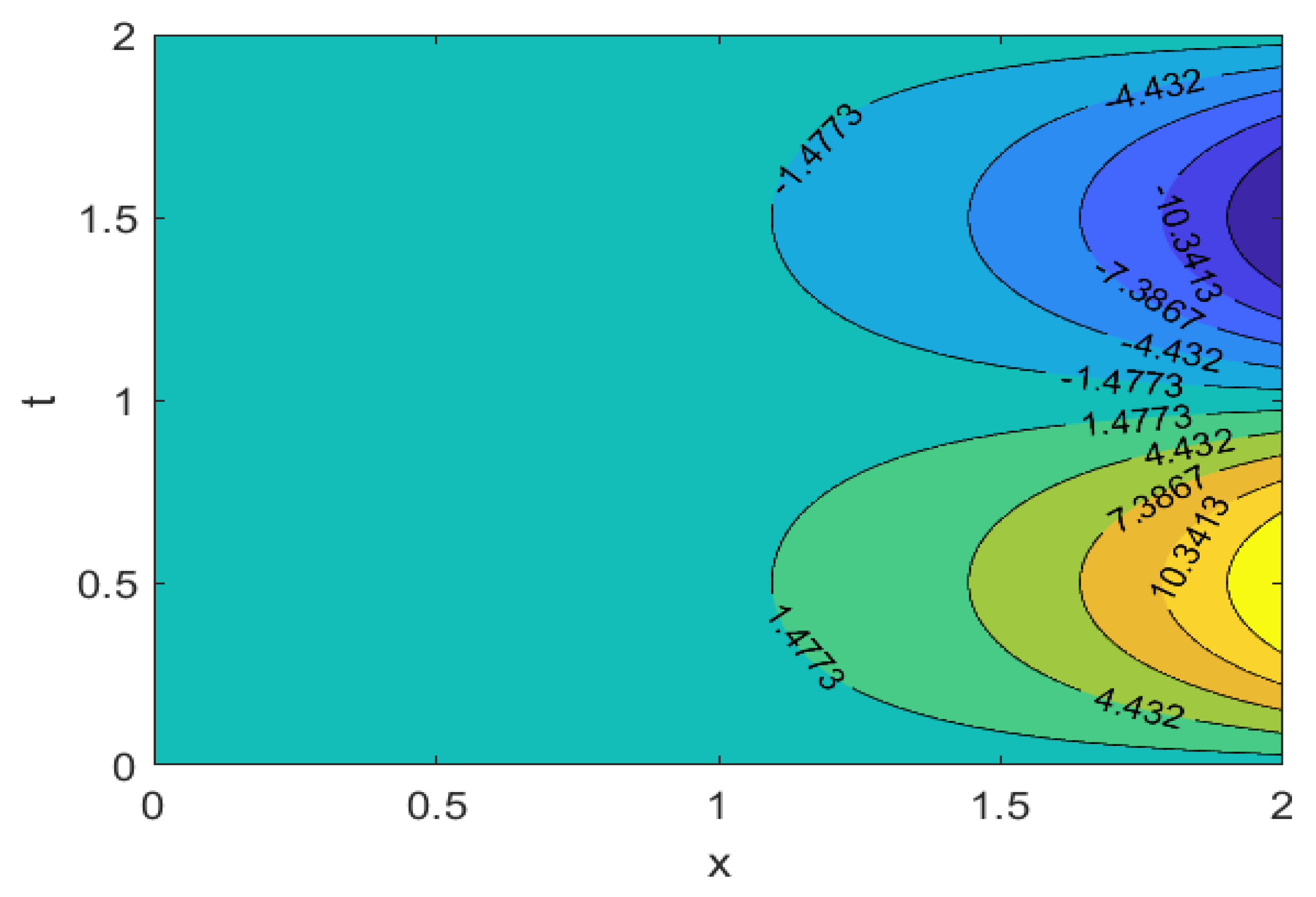
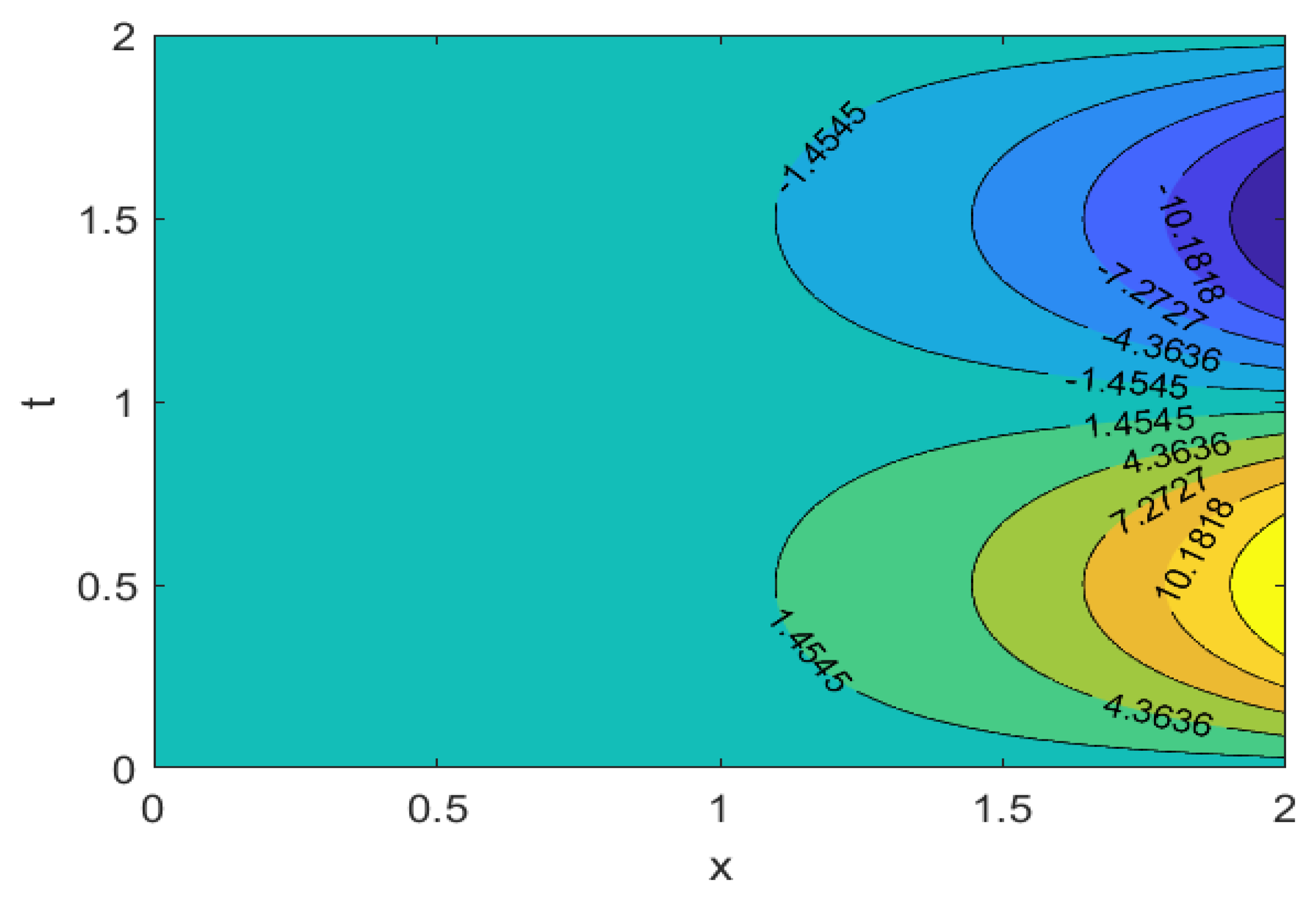
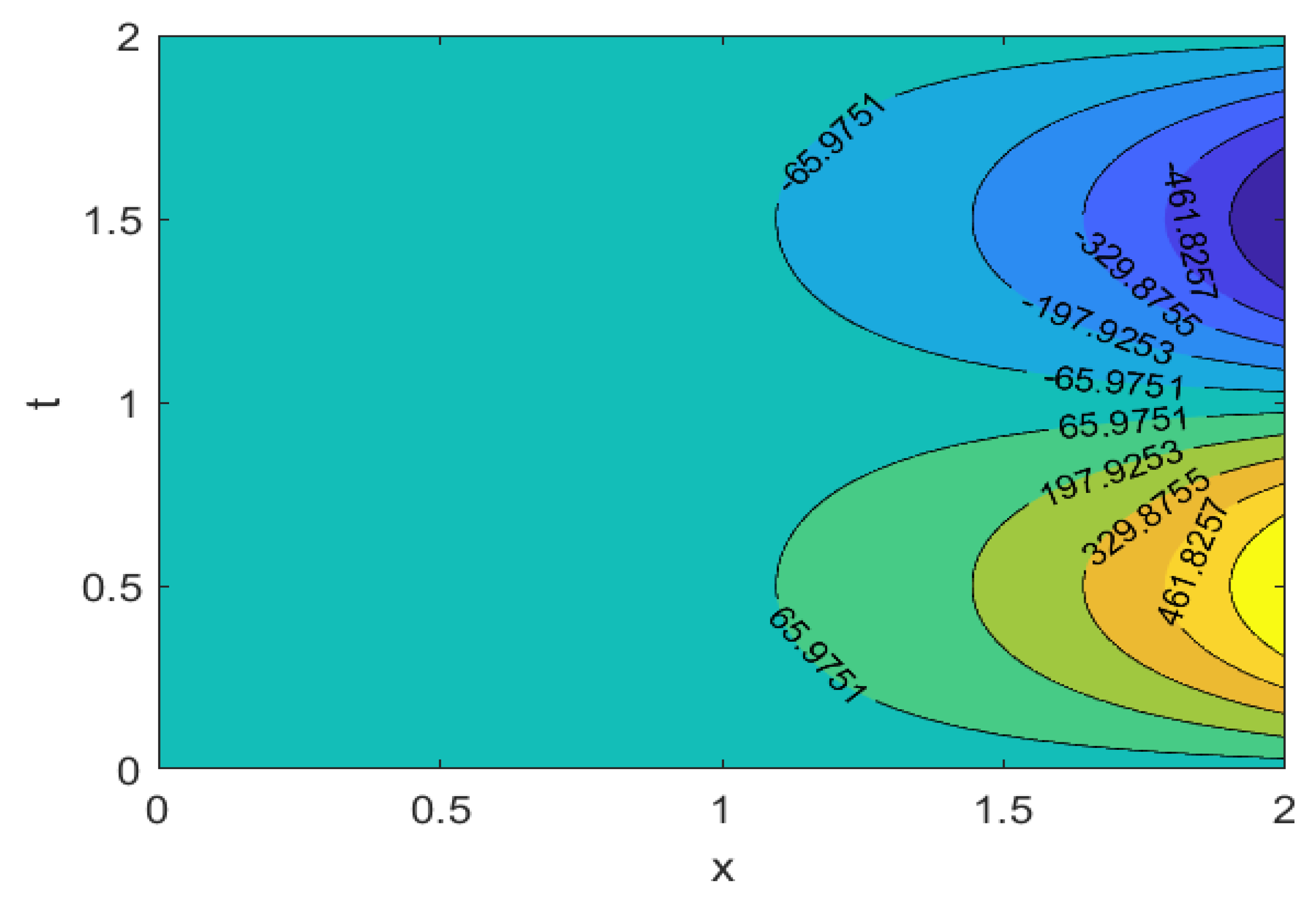
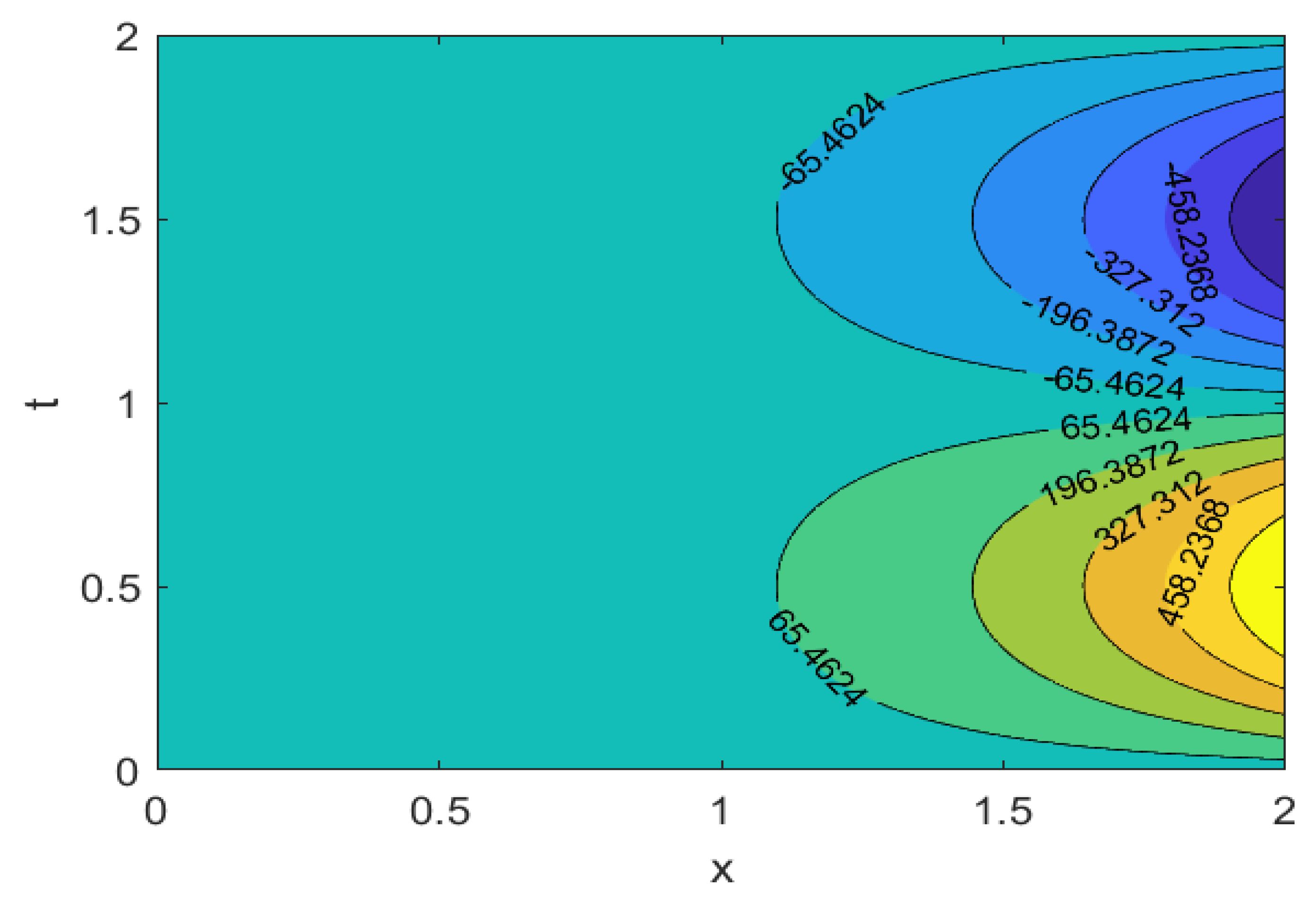
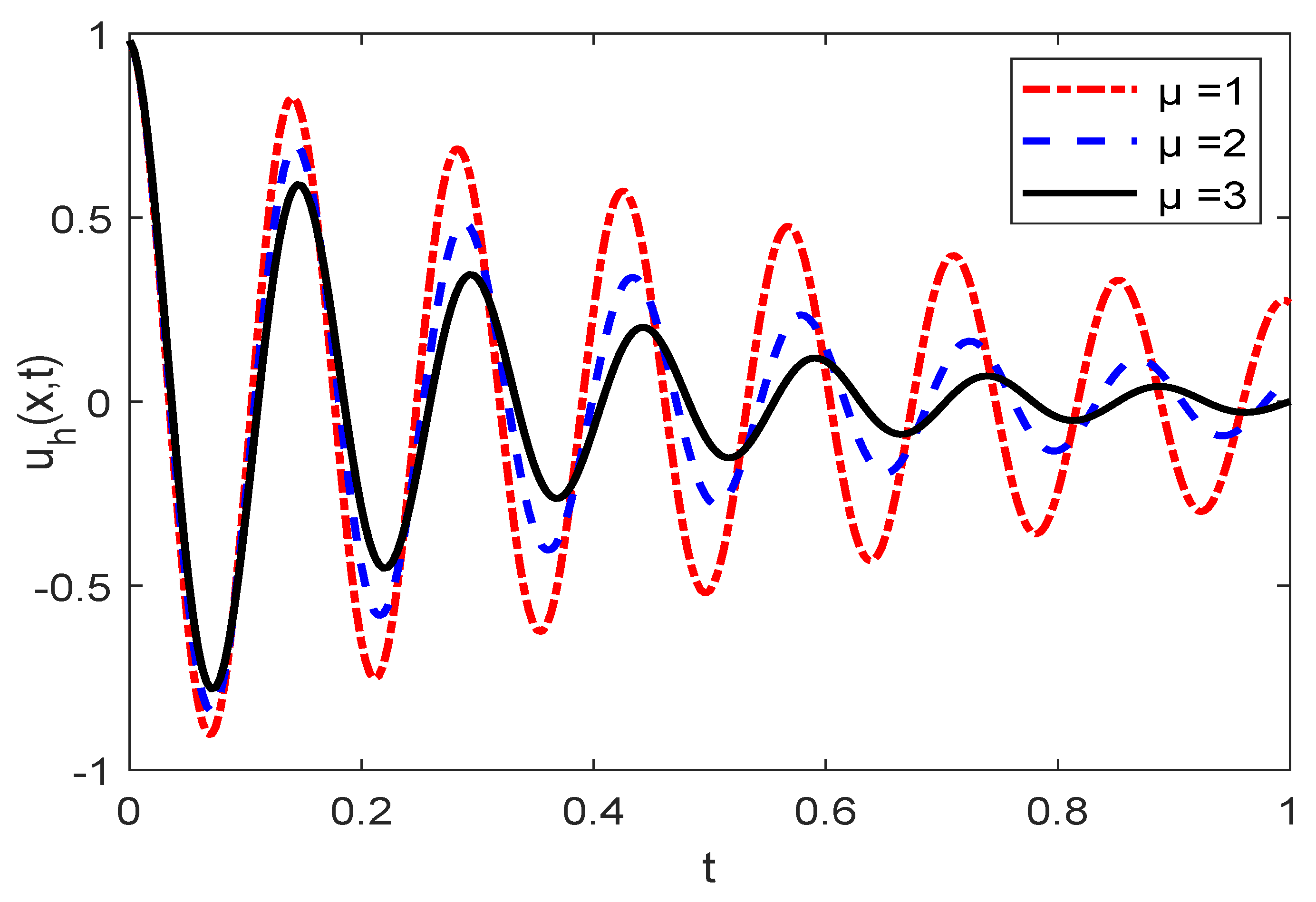
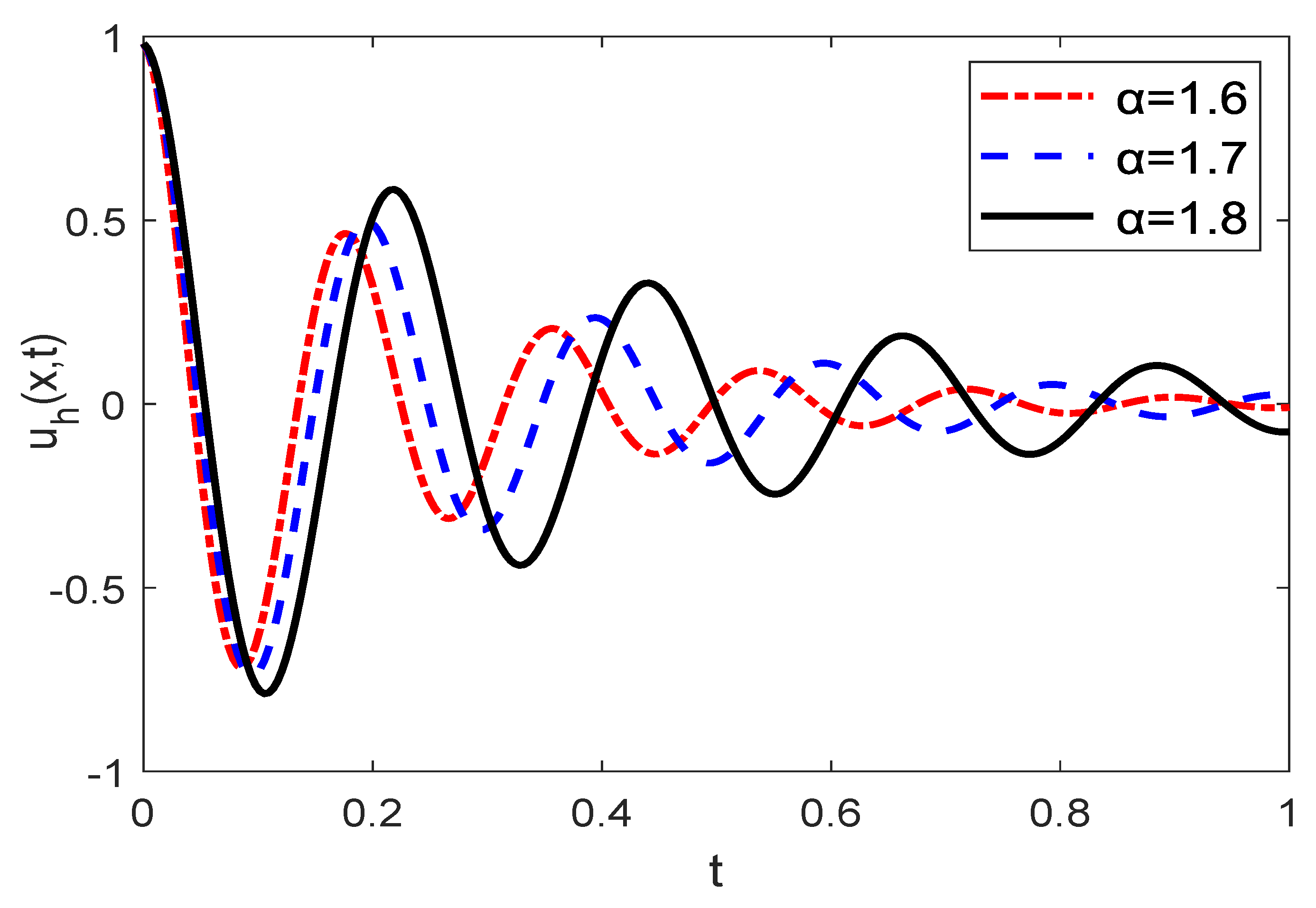
| Order | Order | Order | |||||
|---|---|---|---|---|---|---|---|
| 1/10 | 3.0223 | − | 4.0686 | − | 6.3215 | − | |
| 1/20 | 1.4641 | 1.046 | 2.0832 | 0.965 | 3.1727 | 0.995 | |
| 1/40 | 7.1948 | 1.025 | 1.0506 | 0.988 | 1.5877 | 0.999 | |
| 1/80 | 3.5650 | 1.013 | 5.2749 | 0.994 | 7.9404 | 1.000 | |
| 1/10 | 3.0233 | − | 4.0756 | − | 6.3245 | − | |
| 1/20 | 1.4641 | 1.046 | 2.0820 | 0.979 | 3.1726 | 0.995 | |
| 1/40 | 7.1945 | 1.025 | 1.0505 | 0.991 | 1.5877 | 0.999 | |
| 1/80 | 3.5648 | 1.013 | 5.2763 | 0.996 | 7.9393 | 1.000 |
| Order | Order | Order | |||||
|---|---|---|---|---|---|---|---|
| 1/10 | 9.4947 | − | 1.2782 | − | 1.9859×10 | − | |
| 1/20 | 4.5997 | 1.046 | 6.5446 | 0.966 | 9.9673 | 0.995 | |
| 1/40 | 2.2603 | 1.025 | 3.3004 | 0.988 | 4.9881 | 0.999 | |
| 1/80 | 1.1200 | 1.013 | 1.6572 | 0.994 | 2.4946 | 1.000 | |
| 1/10 | 9.4979 | − | 1.2804 | − | 1.9869×10 | − | |
| 1/20 | 4.5996 | 1.046 | 6.5407 | 0.969 | 9.9672 | 0.995 | |
| 1/40 | 2.2602 | 1.025 | 3.3001 | 0.987 | 4.9878 | 0.999 | |
| 1/80 | 1.1200 | 1.013 | 1.6576 | 0.993 | 2.4942 | 1.000 |
| h | Order | Order | Order | ||||
|---|---|---|---|---|---|---|---|
| 1/8 | 4.4899 | − | 6.6632 | − | 1.2098 | − | |
| 1/16 | 1.1115 | 2.014 | 1.6676 | 1.999 | 3.0108 | 2.007 | |
| 1/32 | 2.7719 | 2.004 | 4.1700 | 2.000 | 7.5184 | 2.002 | |
| 1/64 | 6.9254 | 2.001 | 1.0426 | 2.000 | 1.8790 | 2.000 | |
| 1/8 | 4.4911 | − | 6.6675 | − | 1.2104 | − | |
| 1/16 | 1.1117 | 2.014 | 1.6683 | 1.999 | 3.0118 | 2.007 | |
| 1/32 | 2.7722 | 2.004 | 4.1717 | 2.000 | 7.5200 | 2.002 | |
| 1/64 | 6.9260 | 2.001 | 1.0430 | 2.000 | 1.8793 | 2.001 |
| h | Order | Order | Order | ||||
|---|---|---|---|---|---|---|---|
| 1/8 | 1.4015 | − | 2.0800 | − | 3.7764 | − | |
| 1/16 | 3.4863 | 2.007 | 5.2305 | 1.992 | 9.4436 | 2.000 | |
| 1/32 | 8.7046 | 2.002 | 1.3095 | 1.998 | 2.3610 | 2.000 | |
| 1/64 | 2.1755 | 2.001 | 3.2750 | 2.000 | 5.9026 | 2.000 | |
| 1/8 | 1.4019 | − | 2.0812 | − | 3.7781 | − | |
| 1/16 | 3.4869 | 2.007 | 5.2328 | 1.992 | 9.4465 | 2.000 | |
| 1/32 | 8.7057 | 2.002 | 1.3101 | 1.998 | 2.3615 | 2.000 | |
| 1/64 | 2.1756 | 2.001 | 3.2762 | 2.000 | 5.9035 | 2.000 |
Publisher’s Note: MDPI stays neutral with regard to jurisdictional claims in published maps and institutional affiliations. |
© 2022 by the authors. Licensee MDPI, Basel, Switzerland. This article is an open access article distributed under the terms and conditions of the Creative Commons Attribution (CC BY) license (https://creativecommons.org/licenses/by/4.0/).
Share and Cite
Wang, T.; Jiang, Z.; Zhu, A.; Yin, Z. A Mixed Finite Volume Element Method for Time-Fractional Damping Beam Vibration Problem. Fractal Fract. 2022, 6, 523. https://doi.org/10.3390/fractalfract6090523
Wang T, Jiang Z, Zhu A, Yin Z. A Mixed Finite Volume Element Method for Time-Fractional Damping Beam Vibration Problem. Fractal and Fractional. 2022; 6(9):523. https://doi.org/10.3390/fractalfract6090523
Chicago/Turabian StyleWang, Tongxin, Ziwen Jiang, Ailing Zhu, and Zhe Yin. 2022. "A Mixed Finite Volume Element Method for Time-Fractional Damping Beam Vibration Problem" Fractal and Fractional 6, no. 9: 523. https://doi.org/10.3390/fractalfract6090523





